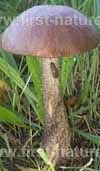Trees Birds Mammals Fish Amphibians Reptiles
Wild Algarve
Bookshop
Boletales Gallery
The order Boletales contains several families including the Boletaceae and Suillaceae, which have spore tubes and pores, the Gomphidiaceae, Tapinellaceae and Paxillaceae - gilled mushrooms closely related to the boletes - and, perhaps surprisingly, the Sclerodermataceae or earthballs.
Suillaceae and Gyroporaceae
Gomphidiaceae, Diplocystidiaceae, and other non-pored members of the order Boletales
More about fungi in the order Boletales

Leccinum
scabrum

Paxillus
involutus

Hygrophoropsis
aurantiaca
Boletes are large cap-and-stipe fungi and much sought after both as a
source of free meals and as beautiful fungi in their own right. The
majority of boletes are edible and some - the Cep or Penny Bun Bolete, Boletus
edulis, is a good example - are considered real delicacies and fetch
high prices in restaurants. There are, however, a few poisonous boletes and others whose bitter taste makes their addition to a mushroom dish inadvisable.
With few exceptions, fungi within the order
Boletales have spore-bearing tubes with pore openings beneath their caps
rather than the more familiar gills of agaricoid cap-and-stipe fungi.
The
most commonly encountered families in this order are the Boletaceae and Suillaceae (all with pores); and Gomphidiaceae and Gyrodontaceae (with gills).
As a general rule, gilled boletes (as they are sometimes called) are
inedible and some - Paxillus involutus, the Brown Roll-rim is one
such example - are known to be toxic. All pored boletes with red or orange
tubes and pores are also best avoided. Suillellus satanas, a large and
very attractive mushroom with bright red pores, is seriously toxic
and so no part of it should be tasted.
Most boletes grow on soil, with
only a minority found on rotting timber and one (Pseudoboletus parasiticus,
the Parasitic Bolete) lives attached to another fungus, Scleroderma
citrinum (the Common Earthball). The most commonly occurring fungi in
this order are from the genera Boletus, Suillus, Leccinum and Paxillus.
Many boletes grow in association with the
roots of just one or a few types of trees, in a 'mycorrhizal relationship'
from which both tree and fungus benefit. Leccinum
scabrum, for example, grows only under birch trees. It is a great help
in identifying some of the more difficult boletes to note which trees they
were growing beneath. Some trees provide mycorrhizal opportunities for
several kinds of boletes. Beech, birches, oaks and Scots Pine are particularly good in this respect.
The popular Penny Bun Bolete (Boletus edulis) is often very
difficult to find among fallen leaves. Surprisingly often, it
occurs in the same general area as the Fly Agaric, Amanita muscaria. So
whenever you find the bright caps of Fly Agaric take a good look around!
The Dictionary of the Fungi by Paul Kirk et al (10th edition, 2008) states that within the family Boletaceae there are 35 genera containing a total of nearly 800 species.
For more information about the order Boletales and a deeper insight into the ecology and structure of the boletes and other species featured in our Boletales Gallery pages, please see Pat O'Reilly's latest book Fascinated by Fungi.
Top of page...
Fascinated by Fungi. Back by popular demand, Pat O'Reilly's best-selling 450-page hardback book is available now. The latest second edition was republished with a sparkling new cover design in September 2022 by Coch-y-Bonddu Books. Full details and copies are available from the publisher's online bookshop...